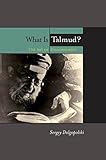What Is Talmud? : The Art of Disagreement / Sergey Dolgopolski.
Material type: TextPublisher: New York, NY : Fordham University Press, [2009]Copyright date: ©2009Description: 1 online resource (320 p.)Content type:
TextPublisher: New York, NY : Fordham University Press, [2009]Copyright date: ©2009Description: 1 online resource (320 p.)Content type: - 9780823229345
- 9780823238767
- 296.1/2506 22
- BM503.6 .D65 2009eb
- online - DeGruyter
| Item type | Current library | Call number | URL | Status | Notes | Barcode | |
|---|---|---|---|---|---|---|---|
 eBook
eBook
|
Biblioteca "Angelicum" Pont. Univ. S.Tommaso d'Aquino Nuvola online | online - DeGruyter (Browse shelf(Opens below)) | Online access | Not for loan (Accesso limitato) | Accesso per gli utenti autorizzati / Access for authorized users | (dgr)9780823238767 |
Browsing Biblioteca "Angelicum" Pont. Univ. S.Tommaso d'Aquino shelves, Shelving location: Nuvola online Close shelf browser (Hides shelf browser)

|

|

|

|

|

|

|
||
| online - DeGruyter Their Other Side : Six American Women and the Lure of Italy / | online - DeGruyter Toward a Theology of Eros : Transfiguring Passion at the Limits of Discipline / | online - DeGruyter Victor Herbert : A Theatrical Life / | online - DeGruyter What Is Talmud? : The Art of Disagreement / | online - DeGruyter Will as Commitment and Resolve : An Existential Account of Creativity, Love, Virtue, and Happiness / | online - DeGruyter Yes, But Not Quite : Encountering Josiah Royce's Ethico-Religious Insight / | online - DeGruyter From Slave Ship to Harvard : Yarrow Mamout and the History of an African American Family / |
Frontmatter -- Contents -- Preface -- Acknowledgments -- Introduction -- PART I. WHAT IS TALMUD? -- 1. What Is Talmud? -- 2. The Talmud in Heidegger’s Aftermath -- 3. The Art of (the) Talmud -- 4. Talmud as Event -- PART TWO: THE WAYS OF THE TALMUD IN ITS RHETORICAL DIMENSION -- 5. The Ways of the Talmud in Its Rhetorical Dimension: A Performative Analytical Description -- PART THREE: THE ART OF DISAGREEMENT -- 6. The Art of Disagreement -- Notes -- Works Cited -- Index
restricted access online access with authorization star
http://purl.org/coar/access_right/c_16ec
True disagreements are hard to achieve, and even harder to maintain, for the ghost of final agreement constantly haunts them. The Babylonian Talmud, however, escapes from that ghost of agreement, and provokes unsettling questions: Are there any conditions under which disagreement might constitute a genuine relationship between minds? Are disagreements always only temporary steps toward final agreement? Must a community of disagreement always imply agreement, as in an agreement to disagree? What is Talmud? rethinks the task of philological, literary, historical, and cultural analysis of the Talmud. It introduces an aspect of this task that has best been approximated by the philosophical, anthropological, and ontological interrogation of human being in relationship to the Other-whether animal, divine, or human. In both engagement and disengagement with post-Heideggerian traditions of thought, Sergey Dogopolski complements philological-historical and cultural approaches to the Talmud with a rigorous anthropological, ontological, and Talmudic inquiry. He redefines the place of the Talmud and its study, both traditional and academic, in the intellectual map of the West, arguing that Talmud is a scholarly art of its own and represents a fundamental intellectual discipline, not a mere application of logical, grammatical, or even rhetorical arts for the purpose of textual hermeneutics. In Talmudic intellectual art, disagreement is a fundamental category. What Is Talmud? rediscovers disagreement as the ultimate condition of finite human existence or co-existence.
Mode of access: Internet via World Wide Web.
In English.
Description based on online resource; title from PDF title page (publisher's Web site, viewed 03. Jan 2023)


